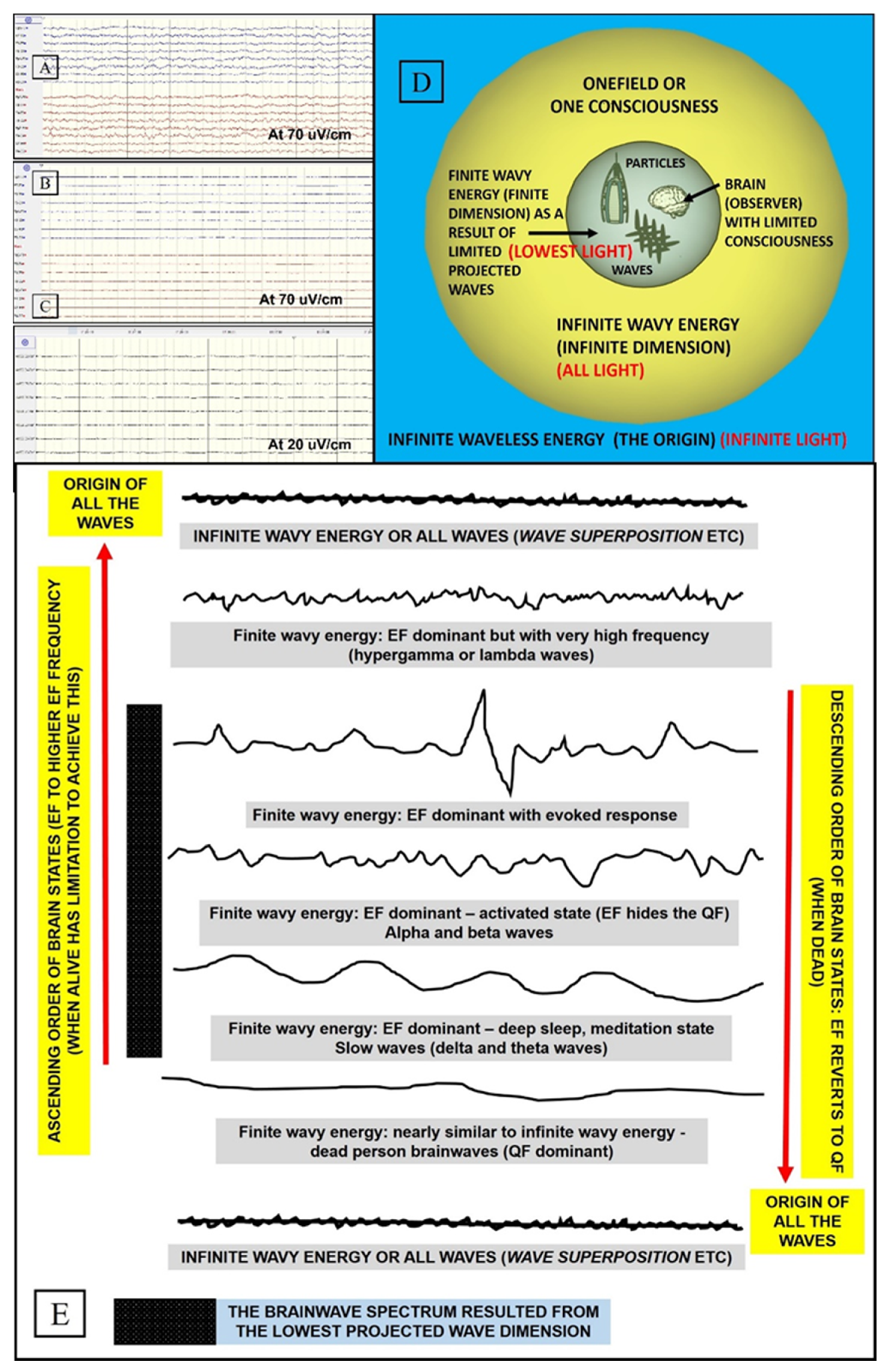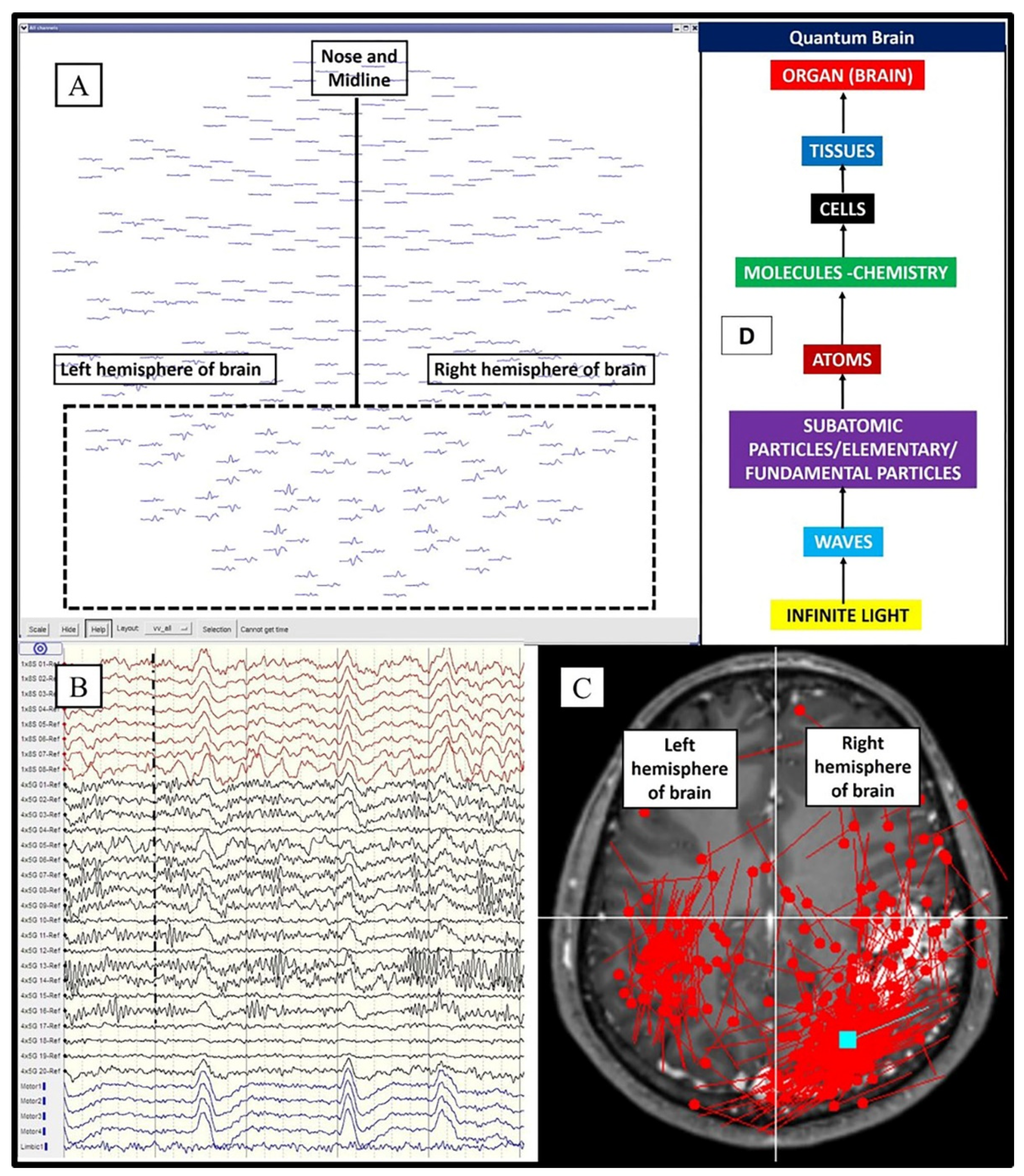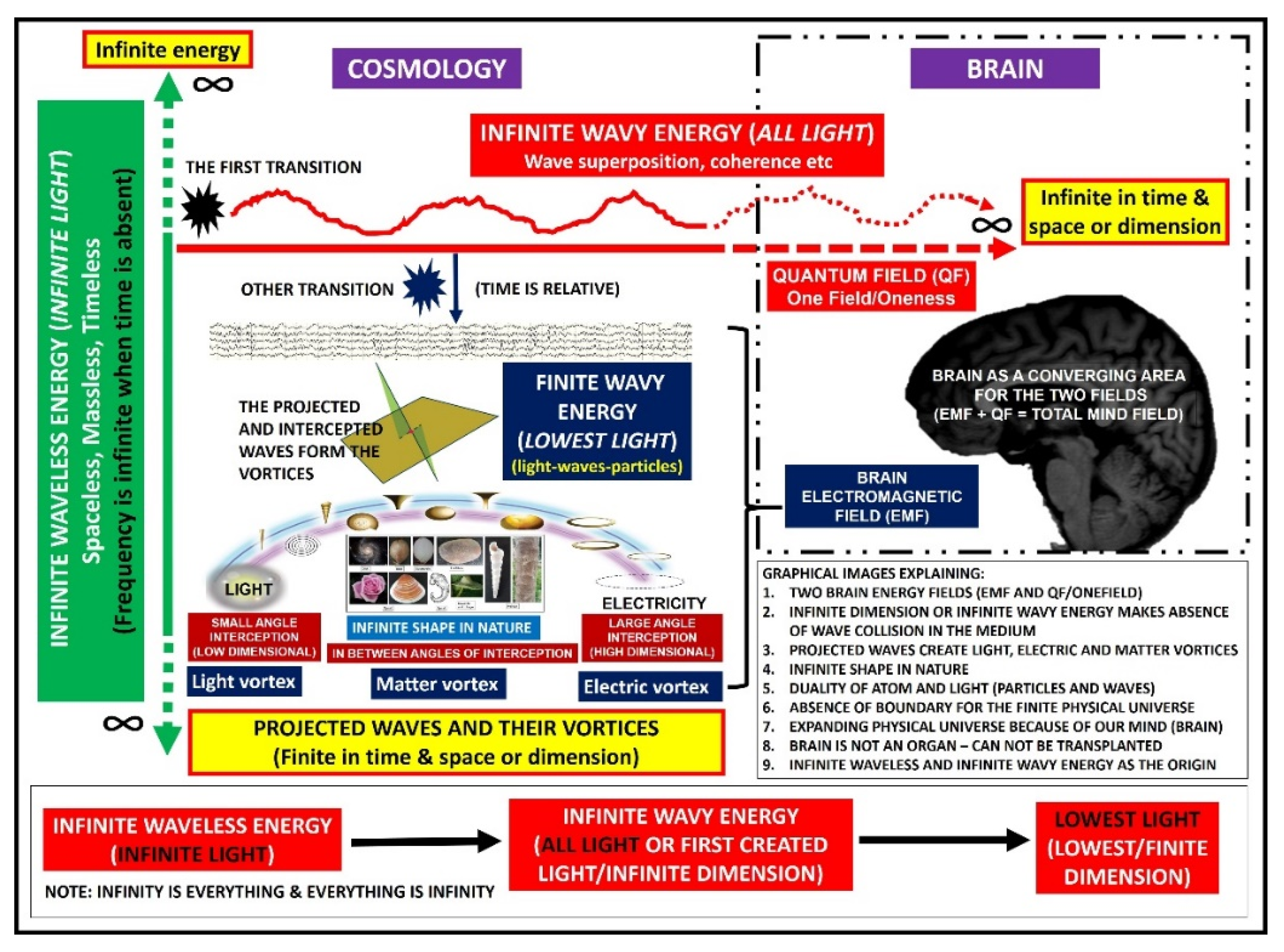Quantum and Electromagnetic Fields in Our Universe and Brain: A New Perspective to Comprehend Brain Function
Abstract
1. Introduction
2. Infinite and Finite Field Energy
3. Physical Universe and Mind (Observer)
4. Wave and Consciousness as a Limitless (Infinite) and Limited (Finite) Entity
5. Fusion of Electrical and Quantum Fields inside the Brain: Fusion of Bohmian and Quantum Mechanics and Their Algorithms
6. Conclusions
Author Contributions
Funding
Institutional Review Board Statement
Informed Consent Statement
Data Availability Statement
Conflicts of Interest
References
- Compton, A. A Quantum Theory of the scattering of X-rays by light elements. Phys. Rev. 1923, 21, 483–502. [Google Scholar] [CrossRef]
- Thomson, G.P.; Reid, A. Diffraction of cathode rays by a thin film. Nature 1927, 119, 890. [Google Scholar] [CrossRef]
- Bohr, N. The Quantum Postulate and the recent development of atomic theory. Nature 1928, 121, 580–590. [Google Scholar] [CrossRef]
- Arndt, M.; Nairz, O.; Vos-Andreae, J.; Keller, C.; Van Der Zouw, G.; Zeilinger, A. Wave-particle duality of C(60) molecules. Nature 1999, 401, 680–682. [Google Scholar] [CrossRef] [PubMed]
- Sakai, K. Simultaneous measurement of wave and particle properties using modified Young’s double-slit experiment. J. Appl. Phys. 2018, 5, 49–54. [Google Scholar]
- Yuan, Y.; Hou, Z.; Zhao, Y.Y.; Zhong, H.S.; Xiang, G.Y.; Li, C.F.; Guo, G.C. Experimental demonstration of wave-particle duality relation based on coherence measure. Opt. Express 2018, 26, 4470–4478. [Google Scholar] [CrossRef]
- Doesburg, S.M.; Green, J.J.; McDonald, J.J.; Ward, L. Rhythms of consciousness: Binocular rivalry reveals large-scale oscillatory network dynamics mediating visual perception. PLoS ONE 2009, 4, e6142. [Google Scholar] [CrossRef]
- Keppler, J. The role of the brain in conscious processes: A new way of looking at the neural correlates of consciousness. Front. Psychol. 2018, 9, 1–8. [Google Scholar] [CrossRef]
- Pletcher, A.E. Quantum cosmology and the role of consciousness. NeuroQuantology 2019, 17, 104–111. [Google Scholar] [CrossRef]
- de Haro, S.; Dieks, D.; Hooft, G.T.; Verlinde, E. Forty Years of String Theory Reflecting on the Foundations. Found. Phys. 2013, 43, 1–7. [Google Scholar] [CrossRef]
- Hooft, G.T. Superstrings and the Foundations of Quantum Mechanics. Found. Phys. 2014, 44, 463–471. [Google Scholar] [CrossRef]
- Idris, Z. An Infinite-Light and Infinite-Frequency in cosmology and neurosciences. Open J. Phil. 2019, 9, 236–251. [Google Scholar] [CrossRef]
- Afsordi, N.; Coriano, C.; Delle Rose, L.; Gould, E.; Skenderis, K. From planck data to planck era: Observational tests of holographic cosmology. Phys. Rev. Lett. 2017, 118, 041301. [Google Scholar] [CrossRef] [PubMed]
- Meijer, D.K.F.; Geesink, H.J.H. Life and consciousness are guided by a semi-harmonic EM background field. NeuroQuantology 2019, 17, 37–44. [Google Scholar] [CrossRef]
- Dembski, W.A. Converting Matter into Mind: Alchemy and the Philosopher’s Stone in Cognitive Science [Online]. Evanston, IL, 1998. Available online: https://www.asa3.org/ASA/PSCF/1990/PSCF12-90Dembski.html (accessed on 2 May 2020).
- Farah, M.J.; Murphy, N. Neuroscience and the soul. Science 2009, 323, 1168. [Google Scholar] [CrossRef]
- Jensen, M.P.; Adachi, T.; Hakimian, S. Brain Oscillations, Hypnosis, and Hypnotizability. Am. J. Clin. Hypn. 2015, 57, 230–253. [Google Scholar] [CrossRef]
- Argento, E.; Papagiannakis, G.; Baka, E.; Maniadakis, M.; Trahanias, P.; Sfakianakis, M.; Nestoros, I. Augmented Cognition via Brainwave Entrainment in Virtual Reality: An Open, Integrated Brain Augmentation in a Neuroscience System Approach. Augment. Hum. Res. 2017, 2, 3. [Google Scholar] [CrossRef][Green Version]
- Hameroff, S.; Penrose, R. Consciousness in the universe: A review of the ‘Orch OR’ theory. Phys Life Rev. 2014, 11, 39–78. [Google Scholar] [CrossRef]
- Li, T.; Tang, H.; Zhu, J.; Zhang, J.H. The finer scale of consciousness: Quantum theory. Ann. Transl. Med. 2019, 7, 585. [Google Scholar] [CrossRef]
- Meijer, D.K.F.; Geesink, H.J.H. Consciousness in the Universe is Scale Invariant and Implies an Event Horizon of the Human Brain. NeuroQuantology 2017, 15, 41–79. [Google Scholar] [CrossRef]
- Venis, P. Waves Dimens. 2017. Available online: http://www.infinity-theory.com/en/science/Main_pages/Waves_and_Dimensions (accessed on 20 December 2020).
- Idris, Z.; Reza, F.; Abdullah, J.M. Human brain anatomy: Prospective, microgravity, hemispheric brain specialisation and death of a person. In Human Anatomy—Reviews and Medical Advances; Sisu, A.M., Ed.; IntechOpen: London, UK, 2017. [Google Scholar]
- Idris, Z.; Wan Hassan, W.M.N.; Mustapha, M.; Idris, B.; Ghani, A.R.I.; Abdullah, J.M. Functional MRI, Diffusion Tensor Imaging, Magnetic Source Imaging and Intraoperative Neuromonitoring Guided Brain Tumor Resection in Awake and Under General Anaesthesia. In Clinical Management and Evolving Novel Therapeutic Strategies for Patients with Brain Tumors; Lichtor, T., Ed.; IntechOpen: London, UK, 2013. [Google Scholar]
- Idris, Z.; Ang, S.Y.; Wan Hassan, W.M.N.; Hassan, M.H.; Mohd Zain, K.A.; Abdul Manaf, A. A Clinical Test for a Newly Developed Direct Brain Cooling System for the Injured Brain and Pattern of Cortical Brainwaves in Cooling, Noncooling, and Dead Brain. Ther. Hypothermia Temp. Manag. 2021. [Google Scholar] [CrossRef]
- Hinterberger, T.; Schmidt, S.; Kamei, T.; Walach, H. Decreased electrophysiological activity represents the conscious state of emptiness in meditation. Front. Psychol. 2014, 5, 99. [Google Scholar] [CrossRef]
- Vialatte, F.B.; Bakardjian, H.; Prasad, R.; Cichocki, A. EEG paroxysmal gamma waves during Bhramari Pranayama: A yoga breathing technique. Conscious Cogn. 2009, 18, 977–988. [Google Scholar] [CrossRef] [PubMed]
- Monkul, E.S.; Hatch, J.P.; Nicoletti, M.A.; Spence, S.; Brambilla, P.; Lacerda, A.L.; Sassi, R.B.; Mallinger, A.G.; Keshavan, M.S.; Soares, J.C. Fronto-limbic brain structures in suicidal and non-suicidal female patients with major depressive disorder. Mol. Psychiatry 2007, 12, 360–366. [Google Scholar] [CrossRef] [PubMed]
- Orikabe, L.; Yamasue, H.; Inoue, H.; Takayanagi, Y.; Mozue, Y.; Sudo, Y.; Ishii, T.; Itokawa, M.; Suzuki, M.; Kurachi, M.; et al. Reduced amygdala and hippocampal volumes in patients with methamphetamine psychosis. Schizophr. Res. 2011, 132, 183–189. [Google Scholar] [CrossRef] [PubMed]
- Haukvik, U.K.; Hartberg, C.B.; Agartz, I. Schizophrenia-what does structural MRI show? Tidsskr Nor Laegeforen. 2013, 133, 850. [Google Scholar] [CrossRef] [PubMed]
- Selek, S.; Nicoletti, M.; Zunta-Soares, G.B.; Hatch, J.P.; Nery, F.G.; Matsuo, K.; Sanches, M.; Soares, J.C. A longitudinal study of fronto-limbic brain structures in patients with bipolar I disorder during lithium treatment. J Affect. Disord. 2013, 150, 629–633. [Google Scholar] [CrossRef]
- Lee, K.; Lee, Y.M.; Park, J.M.; Lee, B.D.; Moon, E.; Jeong, H.J.; Kim, S.Y.; Chung, Y.I.; Kim, J.H. Right hippocampus atrophy is independently associated with Alzheimer’s disease with psychosis. Psychogeriatrics 2019, 19, 105–110. [Google Scholar] [CrossRef]
- Jamali, M.; Golshani, M.; Jamali, Y. A proposed mechanism for mind-brain interaction using extended Bohmian quantum mechanics in Avicenna’s monotheistic perspective. Heliyon 2019, 5, e02130. [Google Scholar] [CrossRef]
- Dolan, B. Soul searching: A brief history of the mind/body debate in the neurosciences. Neurosurg. Focus 2007, 23, E2. [Google Scholar] [CrossRef]
- Idris, Z.; Mustapha, M.; Ghani, R.; Idris, B.; Kandasamy, R.; Abdullah, J.M. Principles, anatomical origin and applications of brainwaves: A review, our experience and hypothesis related to microgravity and the question on soul. J. Biomed. Sci. Eng. 2014, 7, 435–445. [Google Scholar] [CrossRef]






| Feature | Electromagnetic or Electric Field (EMF) | Quantum Field (QF) | |
|---|---|---|---|
| 1 | Origin | Projected waves (physiological waves) | Original waves (anatomic–chemical waves) |
| 2 | Wave pattern | Presence of pilot/directional wave | Diffused (delocalized) waves |
| 3 | Wave characteristics | High-frequency wave (limited frequency range when alive) | Low-frequency wave (unlimited and covers the whole frequency range via quantum wave superposition) |
| 4 | Wavelength | Short wavelength (presence or absence of wave superposition) | Long wavelength (with absolute presence of wave superposition) |
| 5 | Quantum concept | Deterministic (locatable) | Nondeterministic (unlocatable, changing) |
| 6 | Physics concept | Bohmian mechanics | (Truly) quantum mechanics |
| 7 | Dimension | High dimension (electric) | Low dimension (light) |
| 8 | System (energy) Note: The brain is like a mirror to the cosmos, with the brain and universe both having “low and high entropy”. Low entropy is formed from high entropy. | Concentrated organized system (energy) (low entropy) Low entropy is formed from the high-entropy state (EMF/EF originates from the projected and intersected QF waves) | Widespread diffused random system (energy) (high entropy) High entropy gives rise to the low-entropy state (the projected and intersected QF waves which form various vortices give rise to EMF/EF) |
| 9 | Brain network | Simple or specific network (few nodes) | Complex, changing, or nonspecific network |
| 10 | Symmetry | More asymmetry | More symmetry |
| 11 | Evoked response | Large evoked response with few stimuli or trials | Smaller evoked response, which needs a greater number of stimuli/trials and a quantum wave detector |
| 12 | Neuroplasticity (recovery once treated) | Less likely (because of limited field or focal/less diffused waves) | More likely (because of diffused waves and oneness) |
| 13 | Wholeness/oneness/one field concept | No (it is a response to the projected/limited field) | Yes (spreading, interconnecting, and permeating entire universe/field) |
| 14 | Related to psychiatry | Less relevant | More relevant (the brain QF is thought of as related to wholeness, reality, or the one consciousness concept) |
| 15 | Medical concept | Currently described by the Newtonian concept, whereby the brain is divided into anatomy/ensemble of particles and waves (physiological or electromagnetic brainwaves, i.e., the commonly studied waves) | Proposed as the medico-quantum physics concept, whereby an anatomic–chemical quantum brain field exists which remains hidden (anatomy/particle is also regarded as energy quanta/waves or mass is also regarded as energy) When this diffused field combines with the brain electric field, we get the total brain field # |
| 16 | Why is only the brain involved in interacting meaningfully with these two fields? Is it related to the seat of human soul concept? | The brain is the only human structure where these two energy fields (pairs) “converge”, Likely (because the center part of the brain is the origin for physiological brainwaves/EMF or all body functions (seat of soul)) | The brain is the only human structure where these two energy fields (pairs) “converge” Likely, the cosmos QF can interact meaningfully with only the brain, which has a seat of soul concept, resulting in the total brain field or mind field (see # above) |
| Brain Function | Combination of EMF and QF (Total Brain Field or Two Brain Fields/Energy) | ||
| A | Brain function (motor, sensory, vision, sound, touch) and its impairment | Noncognitive impairment such as stroke affecting motor, sensory, vision, sound, touch. EMF is more affected than QF. It is measurable and associated with degree of impairment | |
| B | Brain function (language, emotion, memory, attention, planning, etc.) and its impairment | Cognitive impairment of language, emotion, memory, attention, planning, etc. QF is affected significantly, together with EMF. It is also measurable and associated with degree of impairment | |
| C | Brain function and psychosis | Psychotic manifestations such as auditory or visual hallucinations, thought insertions, and delusions QF is likely more affected than EMF (i.e., not related to projected waves or, in other words, no stimuli) or there is an abnormal total brain field or abnormal interaction between the two fields -Yes or no; presence or absence, i.e., not associated with degree of impairment) | |
Publisher’s Note: MDPI stays neutral with regard to jurisdictional claims in published maps and institutional affiliations. |
© 2021 by the authors. Licensee MDPI, Basel, Switzerland. This article is an open access article distributed under the terms and conditions of the Creative Commons Attribution (CC BY) license (https://creativecommons.org/licenses/by/4.0/).
Share and Cite
Idris, Z.; Zakaria, Z.; Yee, A.S.; Fitzrol, D.N.; Ghani, A.R.I.; Abdullah, J.M.; Wan Hassan, W.M.N.; Hassan, M.H.; Manaf, A.A.; Chong Heng, R.O. Quantum and Electromagnetic Fields in Our Universe and Brain: A New Perspective to Comprehend Brain Function. Brain Sci. 2021, 11, 558. https://doi.org/10.3390/brainsci11050558
Idris Z, Zakaria Z, Yee AS, Fitzrol DN, Ghani ARI, Abdullah JM, Wan Hassan WMN, Hassan MH, Manaf AA, Chong Heng RO. Quantum and Electromagnetic Fields in Our Universe and Brain: A New Perspective to Comprehend Brain Function. Brain Sciences. 2021; 11(5):558. https://doi.org/10.3390/brainsci11050558
Chicago/Turabian StyleIdris, Zamzuri, Zaitun Zakaria, Ang Song Yee, Diana Noma Fitzrol, Abdul Rahman Izaini Ghani, Jafri Malin Abdullah, Wan Mohd Nazaruddin Wan Hassan, Mohd Hasyizan Hassan, Asrulnizam Abdul Manaf, and Raymond Ooi Chong Heng. 2021. "Quantum and Electromagnetic Fields in Our Universe and Brain: A New Perspective to Comprehend Brain Function" Brain Sciences 11, no. 5: 558. https://doi.org/10.3390/brainsci11050558
APA StyleIdris, Z., Zakaria, Z., Yee, A. S., Fitzrol, D. N., Ghani, A. R. I., Abdullah, J. M., Wan Hassan, W. M. N., Hassan, M. H., Manaf, A. A., & Chong Heng, R. O. (2021). Quantum and Electromagnetic Fields in Our Universe and Brain: A New Perspective to Comprehend Brain Function. Brain Sciences, 11(5), 558. https://doi.org/10.3390/brainsci11050558








